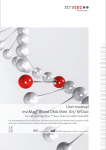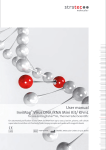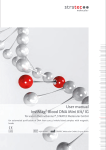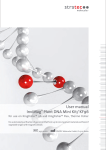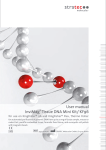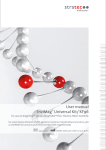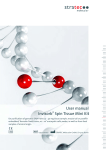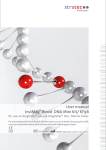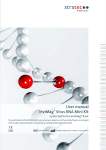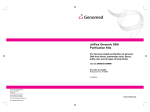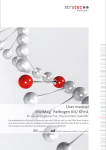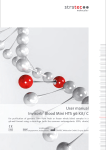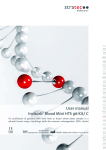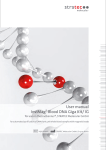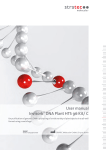Download InviMag Blood DNA Mini Kit/ KFmL User manual
Transcript
User manual InviMag® Blood DNA Mini Kit/ KFmL for use on KingFisher®mL, Thermo Fisher Scientific for automated purification of total DNA from up to 200 µl of whole blood samples, buffy coat, non mammalian blood, bone marrow, and swabs with magnetic beads IVD REF 2431110x00 STRATEC Molecular GmbH, D-13125 Berlin Instruction InviMag® Blood DNA Mini Kit/ KFmL The InviMag® Blood DNA Mini Kit/ KFmL combines the advantages of the innovative Invisorb® technology with easy handling of magnetic particles for a very efficient and reliable isolation of nucleic acids with a high purity. The DNA-binding magnetic particles are characterized by a high surface area, a uniform size distribution, and good suspension stability. They are highly suitable for high-throughput processing. The InviMag® Blood DNA Mini Kit/ KFmL for isolation and purification of total (genomic and mitochondrial) DNA from whole blood samples, buffy coat, non-mammalian blood, cerebrospinal fluid (CSF), bone marrow, and swabs in a single well format for up to 15 samples per run is designed for an optimal use on the KingFisher® mL workstation from Thermo Scientific. The interplay of the DNA extraction and purification chemistry provided by the InviMag® Blood DNA Mini Kit/ KFmL with the KingFisher machine was intensely tested and validated. The kit is neither suitable for isolation of DNA from stool samples, tissue samples, bacteria, fungi, plants or viruses nor for purification of RNA. IVD Compliance with EU Directive 98/79/EC on in vitro medical devices. Not for in vitro diagnostic use in countries where the EU Directive 98/79/EC on in vitro medical devices is not recognized. Trademarks: InviMag®, Invisorb®. Registered marks, trademarks, etc. used in this document, even when not specifically marked as such, are not to be considered unprotected by law. The Invisorb® technology is covered by patents and patent applications: US 6,110363, US 6,043,354, US 6,037,465, EP 0880535, WO 9728171, WO 9534569, EP 0765335, DE 19506887, DE 10041825.2, WO 0034463. InviMag® and Invisorb® are registered trademarks of STRATEC Biomedical AG. The PCR process is covered by US Patents 4,683,195, and 4,683,202 and foreign equivalents owned by Hoffmann-La Roche AG. © 2015 STRATEC Molecular, all rights reserved. 1 ® InviMag Blood DNA Mini Kit/ KFmL 0515 Content Kit contents of InviMag® Blood DNA Mini Kit/ KFmL 3 Kit contents of InviMag® Blood DNA Mini Kit/ KFmL / w/o plastic 4 Symbols 5 Storage 5 Quality control 5 Intended use 6 Product use limitation 6 Safety information 7 Product characteristics of the InviMag® Blood DNA Mini Kit/ KFmL 8 Sampling and sample storage of the starting material 9 Principle and procedure 9 Yield and quality of genomic DNA 10 Reagents and equipment to be supplied by user 10 Important points before starting a protocol 11 Preparing reagents and buffers 11 ® Scheme of the InviMag Blood DNA Mini Kit/ KFmL 12 Protocol 1: Isolation of genomic DNA from up to 200 µl of whole blood or 1–30 µl buffy coat 13 Protocol 2: Isolation of genomic DNA from up to 25 µl of non mammalian blood 13 Protocol 3: Isolation of genomic DNA from CSF and bone marrow 14 Protocol 4: Isolation of genomic DNA from swabs or rinsed liquid from swabs 14 Starting a run - Preliminary Steps to process the sample onto the KingFisher System 16 For self programming the KFmL system 17 Troubleshooting 19 Appendix 20 General notes on handling DNA 21 Ordering information 22 2 ® InviMag Blood DNA Mini Kit/ KFmL 0515 Kit contents of InviMag® Blood DNA Mini Kit/ KFmL Store the SNAP Solution at 4°C! Store dissolved Proteinase K at -20°C! Store all other kit components at room temperature (RT)! 15 extractions 75 extractions 300extractions Catalogue No. 2431110100 2431110200 2431110400 Lysis Buffer A 5 ml 20 ml 70 ml for 0.5 ml working solution for 2 ml working solution for 7 ml working solution 0.5 ml 2 x 1 ml 7 ml 3 ml (final volume 10 ml) 2 x 9 ml (final volume 2 x 30 ml) 2 x 24 ml (final volume 2 x 80 ml) Proteinase K (working solution) SNAP Solution Binding Buffer B6 Wash Buffer I 7.5 ml 2 x 30 ml 2 x 80 ml (final volume 15 ml) (final volume 2 x 60 ml) (final volume 2 x 160 ml) 18 ml 45 ml 3 x 60 ml (final volume 60 ml) (final volume 150 ml) (final volume 3 x 200 ml) 2 x 2 ml 20 ml 70 ml KingFisher mL Tip Combs 3 15 60 KingFisher mL Tube Strips 15 5 x 15 300 1.5 ml Receiver Tubes 15 5 x 15 6 x 50 Manual 1 1 1 Add 7 ml 99.7% Isopropanol to the Binding Buffer B6. Mix by intensive shaking by inverting for 1 min. Shortly before use mix by inverting several times. Add 21 ml 99.7% Isopropanol to each Binding Buffer B6. Mix by intensive shaking by inverting for 1 min. Shortly before use mix by inverting several times. Add 56 ml 99.7% Isopropanol to each Binding Buffer B6. Mix by intensive shaking by inverting for 1 min. Shortly before use mix by inverting several times. Dilute Proteinase K by addition of 2 ml ddH2O, mix thoroughly until completely dissolving and store at 20°C! Dilute Proteinase K by addition of 7 ml ddH2O, mix thoroughly until completely dissolving and store at 20°C! Add 30 ml of 96-100% ethanol to the bottle Wash Buffer I, mix thoroughly and always keep the bottle firmly closed! Add 80 ml of 96-100% ethanol to each bottle Wash Buffer I, mix thoroughly and always keep the bottle firmly closed! Add 105 ml of 96-100% ethanol to the bottle Wash Buffer II, mix thoroughly and always keep the bottle firmly closed! Add 140 ml of 96-100% ethanol to each bottle Wash Buffer II, mix thoroughly and always keep the bottle firmly closed! Wash Buffer II Elution Buffer Initial steps Dilute Proteinase K by addition of 0.5 ml ddH2O, mix thoroughly until completely dissolving and store at -20°C! Add 7.5 ml of 96-100% ethanol to the bottle Wash Buffer I, mix thoroughly and always keep the bottle firmly closed! Add 42 ml of 96-100% ethanol to the bottle Wash Buffer II, mix thoroughly and always keep the bottle firmly closed! 3 ® InviMag Blood DNA Mini Kit/ KFmL 0515 Kit contents of InviMag® Blood DNA Mini Kit/ KFmL/ w/o plastic Store the SNAP Solution at 4°C! Store dissolved Proteinase K at -20°C! Store all other kit components at room temperature (RT)! 15 extractions 75 extractions 300extractions Catalogue No. 2431110150 2431110250 2431110450 Lysis Buffer A 5 ml 20 ml 70 ml for 0.5 ml working solution for 2 ml working solution for 7 ml working solution 0.5 ml 2 x 1 ml 7 ml 3 ml (final volume 10 ml) 2 x 9 ml (final volume 2 x 30 ml) 2 x 24 ml (final volume 2 x 80 ml) Proteinase K (working solution) SNAP Solution Binding Buffer B6 Wash Buffer I 7.5 ml 2 x 30 ml 2 x 80 ml (final volume 15 ml) (final volume 2 x 60 ml) (final volume 2 x 160 ml) 18 ml 45 ml 3 x 60 ml (final volume 60 ml) (final volume 150 ml) (final volume 3 x 200 ml) 2 x 2 ml 20 ml 70 ml 1.5 ml Receiver Tubes 15 5 x 15 6 x 50 Manual 1 1 1 Wash Buffer II Elution Buffer Initial steps Add 7 ml 99.7% Isopropanol to the Binding Buffer B6. Mix by intensive shaking by inverting for 1 min. Shortly before use mix by inverting several times. Dilute Proteinase K by addition of 0.5 ml ddH2O, mix thoroughly until completely dissolving and store at -20°C! Add 7.5 ml of 96-100% ethanol to the bottle Wash Buffer I, mix thoroughly and always keep the bottle firmly closed! Add 42 ml of 96-100% ethanol to the bottle Wash Buffer II, mix thoroughly and always keep the bottle firmly closed! Add 21 ml 99.7% Isopropanol to each Binding Buffer B6. Mix by intensive shaking by inverting for 1 min. Shortly before use mix by inverting several times. Add 56 ml 99.7% Isopropanol to each Binding Buffer B6. Mix by intensive shaking by inverting for 1 min. Shortly before use mix by inverting several times. Dilute Proteinase K by addition of 2 ml ddH2O, mix thoroughly until completely dissolving and store at 20°C! Dilute Proteinase K by addition of 7 ml ddH2O, mix thoroughly until completely dissolving and store at 20°C! Add 30 ml of 96-100% ethanol to the bottle Wash Buffer I, mix thoroughly and always keep the bottle firmly closed! Add 80 ml of 96-100% ethanol to each bottle Wash Buffer I, mix thoroughly and always keep the bottle firmly closed! Add 105 ml of 96-100% ethanol to the bottle Wash Buffer II, mix thoroughly and always keep the bottle firmly closed! Add 140 ml of 96-100% ethanol to each bottle Wash Buffer II, mix thoroughly and always keep the bottle firmly closed! Plastic to be supplied by user (see order information) KingFisher mL Tip Combs 3 15 60 KingFisher mL Tube Strips 15 5 x 15 300 4 ® InviMag Blood DNA Mini Kit/ KFmL 0515 Symbols Manufacturer Lot number Catalogue number Expiry date Consult operating instructions Temperature limitation Do not reuse Storage All buffers and kit contents of the InviMag® Blood DNA Mini Kit/ KFmL except dissolved Proteinase K and SNAP Solution should be stored at room temperature* and are stable for at least 12 months under these conditions. Proteinase K: Dissolved Proteinase K must be stored at -20°C. Dividing the Proteinase K into aliquots and storage at -20°C is recommended. SNAP Solution: SNAP Solution should be stored at 4°C. Wash Buffers: Wash Buffers charged with ethanol should be stored at room temperature* and should be appropriate sealed. If there are any precipitates visible within the provided solutions solve them by carefully warming up to room temperature (up to 30°C). Room temperature (RT) is defined as range from 15-30°C. Quality control and product warranty STRATEC Molecular warrants the correct function of the InviMag® Blood DNA Mini Kit/ KFmL for applications as described in this manual. Purchaser must determine the suitability of the product for its particular use. Should any product fail to perform the applications as described in the manual, STRATEC Molecular will check the lot and if STRATEC Molecular investigates a problem in the lot, STRATEC Molecular will replace the product free of charge. STRATEC Molecular reserves the right to change, alter, or modify any product to enhance its performance and design at any time. In accordance with STRATEC Molecular’s ISO 9001-2000 and ISO EN 13485 certified Quality Management System the performance of all components of the InviMag® Blood DNA Mini Kit/ KFmL have been tested separately against predetermined specifications routinely on lot-to-lot to ensure consistent product quality. If you have any questions or problems regarding any aspects of InviMag® Blood DNA Mini Kit/ KFmL or other STRATEC Molecular products, please do not hesitate to contact us. A copy of STRATEC Molecular’s terms and conditions can be obtained upon request or are presented at the STRATEC Molecular webpage. 5 ® InviMag Blood DNA Mini Kit/ KFmL 0515 For technical support or further information please contact: from Germany: +49-(0)30-9489-2901/ 2910 from abroad: +49-(0)30-9489-2907 or contact your local distributor. Intended use The InviMag® Blood DNA Mini Kit/ KFmL is designed for semi-automated extraction and purification of total (genomic and mitochondrial) DNA from up to 15 whole blood or blood related samples using magnetic beads and the KingFisher mL instrument. The nucleic acid isolation protocol is suitable for routinely automated preparation of DNA from fresh or frozen whole blood sample, buffy coat, non mammalian blood, cerebrospinal fluid (CSF), bone marrow, and swabs. For reproducible and high yields an appropriate sample storage is essential (see “Sampling and storage of the starting material”, page 9). Common blood collection tubes (not provided) and anticoagulants (EDTA, citrate, but not heparin) can be used to assemble a set of blood samples. All utilities (reagents and plastic ware) necessary for preparation of total DNA are provided by the InviMag® Blood DNA Mini Kit/ KFmL in different package sizes. The procedure of the InviMag® Blood DNA Mini Kit/ KFmL is optimized for the isolation of total DNA from up to 200 µl starting material. For samples of a smaller volume than 200 µl please adjust to a total sample volume of 200 µl using distilled water or 1x PBS before starting a purification protocol. THE PRODUCT IS INDENTED FOR USE BY PROFESSIONALS ONLY, SUCH AS TECHNICIANS, PHYSICIANS AND BIOLOGISTS TRAINED IN MOLECULAR BIOLOGICAL TECHNIQUES. It is designed to be used with any downstream application employing enzymatic amplification or other enzymatic modifications of DNA followed by signal detection or amplification. Any diagnostic results generated by using the sample preparation procedure in conjunction with any downstream diagnostic assay should be interpreted with regard to other clinical or laboratory findings. To minimize irregularities in diagnostic results, adequate controls for downstream applications should be used. The kit is in compliance with EU Directive 98/79/EC on in vitro medical devices. But it is not for in vitro diagnostic use in countries where the EU Directive 98/79/EC on in vitro medical devices is not recognized. Product use limitation The kit is neither validated for the isolation of DNA from stool samples, tissue, bacteria, fungi or viruses, nor for isolation and purification of RNA. The included chemicals are only useable once. Differing of starting material or flow trace may lead to inoperability; therefore neither a warranty nor guarantee in this case will be given, neither implied nor express. The user is responsible to validate the performance of the STRATEC Molecular product for any particular use. STRATEC Molecular does not provide for validation of performance characteristics of the product with respect to specific applications. STRATEC Molecular products may be used e.g.in clinical diagnostic laboratory systems conditioned upon the complete diagnostic system of the laboratory the laboratory has been validated pursuant to CLIA’ 88 regulations in the U.S. or equivalents in other countries. All products sold by STRATEC Molecular are subject to extensive quality control procedures (according to ISO 9001-2000 and ISO EN 13485) and are warranted to perform as described herein. Any problems, incidents or defects shall be reported to STRATEC Molecular immediately upon detection thereof. The chemicals and the plastic parts are for laboratory use only; they must be stored in the laboratory and must not be used for purposes other than intended. The product with its contents is unfit for consumption. 6 ® InviMag Blood DNA Mini Kit/ KFmL 0515 Safety information When and while working with chemicals, always wear a suitable lab coat, disposable gloves, and protective goggles! Avoid skin contact! Adhere to the legal requirements for working with biological material! For more information, please consult the appropriate material safety data sheets (MSDS). These are available online in convenient and compact PDF format at www.stratec.com for each STRATEC Molecular product and its components. If buffer bottles are damaged or leaking, WEAR GLOVES, AND PROTECTIVE GOGGLES when discarding the bottles in order to avoid any injuries. STRATEC Molecular has not tested the liquid waste generated by the InviMag® Blood DNA Mini Kit/ KFmL procedures for residual infectious materials. Contamination of the liquid waste with residual infectious materials is highly unlikely, but cannot be excluded completely. Therefore, liquid waste has be considered infectious and be handled and discarded according to local safety regulations. European Community risk and safety phrases for the components of the InviMag® Blood DNA Mini Kit/ KFmL to which they apply, are listed below as follows:. Wash Buffer I contains guanidine thiocyanate which is an irritant. Lysis Buffer A danger H-319 P305-351-338 Proteinase K Wash Buffer I danger H315-319-334-335 P280-305-351-338-310-405 warning H302-312-332-412 EUH032 P273 H319: H315: H334: H335: H302: H312: H332: H412: EUH032: P305+P351+P338: P280: P310: P405: P273: Causes serious eye irritation. Causes skin irritation. May cause allergy or asthma symptoms or breathing difficulties if inhaled. May cause respiratory irritation. Harmful if swallowed. Harmful in contact with skin. Harmful if inhaled. Harmful to aquatic life with long lasting effects. Contact with acids liberates very toxic gas. IF IN EYES: Rinse cautiously with water for several minutes. Remove contact lenses, if present and easy to do. Continue rinsing. Wear protective gloves/protective clothing/eye protection/face protection. Immediately call a POISON CENTER or doctor/physician. Store locked up. Avoid release to the environment. Emergency medical information can be obtained 24 hours a day from infotrac: outside of USA: in USA : 1 – 352 – 323 – 3500 1 – 800 – 535 – 5053 7 ® InviMag Blood DNA Mini Kit/ KFmL 0515 Product characteristics of the InviMag® Blood DNA Mini Kit/ KFmL The InviMag® Blood DNA Mini Kit/ KFmL procedure the ideal tool for an efficient DNA extraction and purification from fresh or frozen whole blood samples, non-mammalian blood, buffy coat, CST, bone marrow, and swabs in a single well format for up to 15 samples per run using magnetic beads and the KingFisher mL. Starting material Yield Time 1-200 µl fresh, frozen or old human or other mammalian whole blood; 1-200 µl cerebrospinal fluid; 1–30 µl buffy coat; 1–25 µl fresh, frozen or old non mammalian blood; 1–20 µl bone marrow; swabs; up to 200 µl rinsed liquid from swab up to 10 µg (in average abou 30 min 6 µg) depends on amount of (without lysis) lymphocytes, sample source sample transport, sample storage, and age of the sample Ratio A260 : A 280 1.7 – 2.0 The DNA isolation process is based on the interaction of nucleic acids with coated magnetic particles under adapted buffer conditions. After lysis, the KingFisher mL performs all steps of the DNA purification procedure automatically without any user intervention. The procedure requires minimal interaction by the user, thus allowing safe handling of potentially infectious samples. Sample cross-contaminations and reagent cross-over are effectively eliminated by this automated purification process. The KingFisher® instruments use magnetic rods to transport the DNA-binding magnetic particles through the various purification phases: binding-washing-elution. The volume of buffers and other liquids necessary for DNA isolation is reduced to a minimum. After an external sample specific cell lysis using Lysis Buffer A and Proteinase K, optimal binding conditions are adjusted upon addition of Binding Solution B6. The total DNA bound to the simultaneously added magnetic particles is separated from solution by the magnetic rods controlled by the KingFisher instrument. Subsequent to the three washing steps of the particle bound nucleic acids, the DNA is finally eluted in Elution Buffer. Due to the high purity, the eluted (genomic and mitochondrial) DNA is ready-to-use for a broad panel of downstream applications: ○ PCR* ○ Restriction Enzyme Digestion ○ HLA Typing ○ Southern Blot. The InviMag® Blood DNA Mini Kit/ KFmL is supplied with a comprehensive manual describing four protocols (page 13-14) for DNA purification from different sources. For the isolation of genomic DNA using magnetic particles in a 96 well format, STRATEC Molecular offers the InviMag® Blood DNA Mini Kit/ KF96/ KFflex96 for use on a KF96 / KFflex96 instrument. For the isolation of DNA from a single blood sample STRATEC Molecular offers the Invisorb® Spin Blood Mini Kit or for 8-96 samples the Invisorb® DNA Blood Mini HTS 96 Kits for use on a centrifuge, vacuum manifold or other robotic stations (see “Ordering Information”, page 22). For further information please contact: Phone +49 (0) 30 9489 2901, 2910 in Germany and from foreign countries phone +49 (0) 30 9489 2907 or your local distributor. * The PCR process is covered by US Patents 4,683,195, and 4,683,202 and foreign equivalents owned by HoffmannLa Roche AG. 8 ® InviMag Blood DNA Mini Kit/ KFmL 0515 Sampling and sample storage of the starting material For reproducible and high yields appropriate sample storage is essential. Yields may be varying from sample to sample depending on factors such as health of the donor, sample age, kind of sample, transport and storage conditions. Blood and Buffy Coat: Best results are obtained using fresh blood samples. Mammalian blood samples (stabilized with EDTA or citrate but not heparin) can be stored at room temperature for up to 2-3 hours. For short-term storage (up to 24 h) samples should be stored at 4°C. For long-term storage, we recommend freezing samples at -20°C or -80°C. Multiple thawing and freezing cycles before isolating the DNA should be avoided. If cryoprecipitates (formed during thawing of frozen samples) are visible avoid aspirating them. Various different primary tubes, blood collection system (e.g. Sarstedt, Greiner) and anticoagulants (except heparin) can be used to collect blood samples for the InviMag® Blood DNA Mini Kit/ KFmL procedure. Buffy coat is a whole-blood fraction of enriched leukocyte cells. To prepare and extract of buffy coat the following procedure is recommended: The use of a whole blood sample (anticoagulants: EDTA, citrate, not heparin) with a sedimented cellular fraction from staying overnight at 4°C is recommended. The resulting bright mid-section overlaid by the clear plasma is the buffy coat containing concentrated leukocytes that can be easily distinguished from the erythrocytes in the bottom layer. An enrichment factor of 10 is expected from such a procedure. Due to the enriched leukocyte content be aware to avoid overloading the purification system. CSF (Cerebrospinal fluid) and Bone marrow: Best results are obtained with fresh material which can be stored for 2-3 h at 4°C or for longterm storage freeze the sample at -20°C. However, often the sample is dried. Dried samples have to be stored at 4°C in a dry surrounding. Swabs The protocol works with fresh prepared swabs as well as with dried swabs. Please note, that stored and dried swabs can lead to samples that show an apoptotic DNA ladder (visible on agarose gel as typical apoptotic DNA banding pattern).The protocol has not been validated for isolation of DNA from swabs which are stored in special storage buffers from other providers. STRATEC Molecular will be released of its responsibilities if other sample materials than described in the Intended Use are processed or if the sample preparation protocols are changed or modified. Principle and procedure The InviMag® Blood DNA Mini Kit/ KFmL procedure comprises following steps: ○ ○ ○ ○ lysis of sample material and protein digestion binding the genomic DNA to the magnetic beads washing the beads and elimination of ethanol elution of genomic DNA After lysis, the DNA binds to the magnetic beads whereas contaminations and inhibitors are efficiently removed during the following three wash steps. Highly purified DNA is eluted in Elution Buffer. This manual contains 4 protocols (page 13-14). 9 ® InviMag Blood DNA Mini Kit/ KFmL 0515 Lysis Lysis is performed at elevated temperatures in the presence of Lysis Buffer A and Proteinase K. In case of large sample numbers we recommend the preparation of a master mix with a volume 5% greater than that required. Carefully mix the master mix carefully prior to use! Binding of the genomic DNA After adding Binding Buffer B6 and SNAP Solution to the lysate the DNA is bound to the surface of the magnetic beads. Removing residual contaminants Contaminants are efficiently washed away using Wash Buffer I and II, while the DNA remains bound to the magnetic beads. Elution The DNA is eluted in 200 µl Elution Buffer. The eluted DNA is ready-to-use in different subsequent downstream applications e.g. for PCR amplification, digestion with restriction enzymes, Southern hybridizations, HLA typing etc. Yield and quality of genomic DNA The amount of purified DNA in the InviMag® Blood DNA Mini Kit/ KFmL procedure from whole blood depends on the leucocytes content, sample source, transport, storage, and sample age. Typically, a 200 μl sample of whole blood cells (samples with elevated white blood cell (WBC counts), ranging from 3x106 to 1x107 cells/ml) from a healthy individual will yield 3–12 μg of DNA. The typical yield usually derived from the InviMag® Blood DNA Mini Kit/ KFmL is about 3-8 µg of DNA. If the whole blood sample is mixed with anticoagulant containing buffers the overall leukocyte concentration decreases and the yield of the DNA extraction procedure is reduced. Yield and quality of isolated genomic DNA is suitable for any molecular-diagnostic detection system. The diagnostic tests should be performed according to manufacturers’ specifications. Reagents and equipment to be supplied by user ○ ○ ○ ○ ○ ○ ○ Measuring cylinder (250 ml) Pipette and pipette tips Disposable gloves Reaction tubes (1.5 ml / 2.0 ml) dd H2O Vortexer 96-100% ethanol ○ Isopropanol* The InviMag® Blood DNA Mini Kit/ KFmL is validated with 2-Propanol; Rotipuran >99.7%, p.a., ACS, ISO (Order no. 6752) from Carl Roth * Possible suppliers for Isopropanol: Carl Roth 2-Propanol Rotipuran >99.7%, p.a., ACS, ISO Order no. 6752 Applichem 2-Propanol für die Molekularbiologie Order no. A3928 10 Sigma 2-Propanol Order no. 59304-1L-F ® InviMag Blood DNA Mini Kit/ KFmL 0515 Important points before starting a protocol Immediately upon receipt of the product, inspect the product and its components as well as the package for any apparent damages, correct quantities and quality. If there are any unconformities you have to notify STRATEC Molecular in writing with immediate effect upon inspection thereof. If buffer bottles are damaged, contact the STRATEC Molecular Technical Services or your local distributor. In case of liquid spillage, refer to “Safety Information” (see page 7). Do not use damaged kit components, since their use may lead to poor kit performance. o Always change pipet tips between liquid transfers. To avoid cross-contamination we recommend the use of aerosol-barrier pipet tips. o All centrifugation steps are carried out at room temperature. o When working with chemicals, always wear a suitable lab coat, disposable gloves and protective goggles. o Discard contaminated gloves immediately. o Do not combine components of different kits, unless the lot numbers are identical. o Avoid microbial contamination of the kit reagents. o To minimize the risk of infections from potentially infectious material, we recommend working under laminar air-flow until the samples are lysed. o This kit should only be used by trained personnel. Preparing reagents and buffers Before starting a run, equilibrate all reagents at room temperature. Where necessary, gently mix and redissolve any precipitates by incubation at 30°C. Swirl gently to avoid foaming. Lysis Buffer A and Elution Buffer are ready-to-use. Add the required amount of dd-H2O (see Kit Contents, page 3) to the reaction tube containing Proteinase K. Vortexing for 5 sec and store diluted Proteinase K at -20°C. 15 DNA-extractions: Add 7 ml 99.7% Isopropanol to the Binding Buffer B6. Mix by intensive shaking by inverting for 1 min. Shortly before use mix by inverting several times. Dilute Proteinase K by addition of 0.5 ml ddH2O, mix thoroughly until completely dissolving and store at -20°C! Add 7.5 ml of 96-100% ethanol to the bottle Wash Buffer I. Add 42 ml of 96-100% ethanol to the bottle Wash Buffer II. 75 DNA-extractions: Add 21 ml 99.7% Isopropanol to each Binding Buffer B6. Mix by intensive shaking by inverting for 1 min. Shortly before use mix by inverting several times. Dilute Proteinase K by addition of 2 ml of ddH2O, mix thoroughly until completely dissolving and store at -20°C! Add 30 ml of 96-100% ethanol to the bottle Wash Buffer I. Add 105 ml of 96-100% ethanol to the bottle Wash Buffer II. Mix thoroughly and keep the bottle always firmly closed! 300 DNA-extractions: Add 56 ml 99.7% Isopropanol to each Binding Buffer B6. Mix by intensive shaking by inverting for 1 min. Shortly before use mix by inverting several times. Dilute Proteinase K by addition of 7 ml ddH2O, mix thoroughly until completely dissolving and store at 20°C! Add 80 ml of 96-100% ethanol to each bottle Wash Buffer I, mix thoroughly and always keep the bottle firmly closed! Add 140 ml of 96-100% ethanol to each bottle Wash Buffer II, mix thoroughly and always keep the bottle firmly closed 11 ® InviMag Blood DNA Mini Kit/ KFmL 0515 Scheme of the InviMag® Blood DNA Mini Kit/ KFmL Please carefully read the protocols before starting a run - If necessary add required amount of dd-H2O or 1x PBS to adjust the sample volume to 200 µl. Transfer 200 µl sample into a 1.5 ml reaction tube (not provided) Add 200 µl Lysis Buffer A and 20 µl Proteinase K. Mix by pipetting up and down or by moving up and down the magnetic rods Incubate the samples at 56°C for 10 min while shaking During lysis, prefill the KingFisher Tube strip(s) with the required buffers and appropriate volumes Tube A: Tube B: Tube C: Tube D: Tube E: Add 400 µl Binding Buffer B6 and 20 µl SNAP Solution Add 800 µl Wash Buffer I. Add 800 µl Wash Buffer II. Add 800 µl Wash Buffer II. Add 200 µl Elution Buffer. Addition of 400 µl Binding Buffer B6 (follow preparing instructions) and 20 µl SNAP Solution with the lysate DNA binds to magnetic particles Magnetic particle separation 3x Washing of the particle fixed DNA (3x 800 µl) Magnetic particle separation Elution of genomic DNA in 200 µl Elution Buffer Magnetic Separation Pure DNA 12 ® InviMag Blood DNA Mini Kit/ KFmL 0515 Protocol 1: Isolation of genomic DNA from up to 200 µl of whole blood or 1–30 µl buffy coat Please read the instructions carefully and conduct the prepared procedure. Attention: Please be aware, that you have to prepare the Binding Buffer B6 – see instruction page: 11 Important Note: The protocol has been optimized for the isolation of genomic DNA from 200 µl of whole blood or 30 µl buffy coat. For samples with a smaller volume than 200 µl, please fill up to a total volume of 200 µl with distilled water or 1x PBS. External Sample lysis in a 1.5 ml reaction tube (not provided) 1. Transfer 200 µl of whole blood or 30 µl buffy coat into a 1.5 ml reaction tube. If the sample volume is lower than 200 µl, equilibrate with sterile water or 1x PBS. 2. Add 200 µl Lysis Buffer A and 20 µl Proteinase K. Important Note: Vortex the sample for 10 s! An incomplete mixing will reduce the quality and yield of the isolated DNA. 3. Incubate the sample at 56°C for 10 min while continuously shaking. 4. During lysis, prefill all tubes of the KingFisher tube strips with the required buffers and appropriate volumes (see “Starting a Run”, page 16). 5. After lysis, transfer the sample(s) carefully into the Tube A of the corresponding KingFisher tube strip prefilled with 400 µl Binding Buffer B6 and 20 µl SNAP Solution Important Note: Vortex the SNAP Solution vigorously before use! 6. Continue with “Starting a run” on page 16 Protocol 2: Isolation of genomic DNA from up to 25 µl of non mammalian blood Please read the instructions carefully and conduct the prepared procedure. Attention: Please be aware, that you have to prepare the Binding Buffer B6 – see instruction page: 11 Important Note: For samples which have a smaller volume than 200 µl please adjust to a total volume of 200 µl using 1x PBS or distilled water. If bird (e. g. chicken) or fish blood should be used that contain nucleated erythrocytes, the use of only 10-15 µl of starting material is recommended. I. Sample Lysis 1. Transfer max. 25 µl of non-mammalian blood (not heparin stabilized) into a 1.5 ml reaction tube. Adjust the sample volume to 200 µl using 1x PBS or distilled water. 2. Add 200 µl Lysis Buffer A and 20 µl Proteinase K. Important Note: Vortex the sample for 10 s! An incomplete mixing step will reduce quality and yield of the isolated DNA. 3. Incubate the sample at 56°C for 25 min while continuously shaking. 4. During lysis, prefill all tubes of the KingFisher mL with required buffers and appropriate volumes (see “Starting a Run”, page 16). 5. After lysis, transfer the sample carefully into Tube A of the KingFisher tube strip prefilled with 400 µl Binding Buffer B6 and 20 µl SNAP Solution (see “Starting a Run”, page 16). 13 ® InviMag Blood DNA Mini Kit/ KFmL 0515 Protocol 3: Isolation of genomic DNA from CSF and bone marrow Please read the instructions carefully and conduct the prepared procedure. Attention: Please be aware, that you have to prepare the Binding Buffer B6 – see instruction page: 11 Important Note: For samples which have a smaller volume than 200 µl please adjust to a total volume of 200 µl using 1x PBS or distilled water Preparation of the starting material: Fresh material: ○ ○ 1–200 µl fresh cerebrospinal fluid 1-20 µl bone marrow Dried material (for example on hematological slides): ○ ○ ○ ○ Moisten the dried material with a drop of PBS. Add 180 µl PBS to a 1.5 ml microcentrifuge tube (not provided). Scrape cytological material into the microcentrifuge tube using the edge of a clean slide. Dissolve the resulting sludge by pipetting up and down. I. Sample Lysis 1. Transfer the starting material into a 1.5 ml reaction tube. If the sample volume is lower than 200 µl, adjust with 1 x PBS Buffer or distilled water. 2. Add 200 µl Lysis Buffer A and 20 µl Proteinase K. Important Note: Vortex the sample for 10 s! An incomplete mixing will reduce quality and yield of the isolated DNA. 3. Incubate the sample at 56°C for 20 min while continuously shaking. 4. During lysis, prefill all tubes of the KingFisher mL with needed buffers and appropriate volumes (see “Starting a Run”, page 16). 5. After the lysis transfer the sample carefully into the Tube A of the KingFisher tube strip prefilled with 400 µl Binding Buffer B6 and 20 µl SNAP Solution (see “Starting a Run”, page 16). Important Note: Vortex the SNAP Solution vigorously before use! Protocol 4: Isolation of genomic DNA from swabs or rinsed liquid from swabs Please read the instructions carefully and conduct the prepared procedure. Attention: Please be aware, that you have to prepare the Binding Buffer B6 – see instruction page: 11 Important Note: For samples which have a smaller volume than 200 µl, please fill up to a total volume of 200 µl with 1x PBS or distilled water. If chicken or fish blood is used a final sample volume of 10 µl is recommended. 14 ® InviMag Blood DNA Mini Kit/ KFmL 0515 Fresh or dried swabs I. Sample Lysis 1. Add 180 µl PBS-Buffer or distilled water to 1.5 ml reaction tube (not provided). Transfer the swab into the tube and incubate for 3 min. Afterwards add 200 µl Lysis Buffer A and 20 µl Proteinase K. Mix by pipetting up and down (5 times). 2. Incubate the reaction tube at 56°C for 20 min while continuously shaking on a thermomixer. Important Note: To get maximum yield of DNA, it is essential to leave the swab inside the tube during the complete lysis time. It is possible to cut-off the shaft of the swab to allow closing of reaction tube cap. The removing of the swab from the reaction tube ahead of time will lead to a dramatically reduced final yield! 3. During lysis, prefill all tubes of the KingFisher mL with required buffers and appropriate volumes (see “Starting a Run”, page 16). 4. After lysis, carefully squeeze out the swab inside the tube wall and discard the swab. Transfer the sample carefully into Tube A of the KingFisher tube strip prefilled with 400 µl Binding Buffer B6 and 20 µl SNAP Solution (see “Starting a Run”, page 16). Important Note: Vortex the SNAP Solution vigorously before use! Swabs delivered in transportation media Important: If the swab is delivered in stabilization media, ensure that these media are compatible with the STRATEC Molecular chemistry. For more information contact STRATEC Molecular: phone + 49 30 9489 2907 1. Transfer 200 µl of the transportation media into a 1.5 ml reaction tube. If the sample volume is lower than 200 µl, equilibrate with 1x PBS or distilled water. 2. Add 200 µl Lysis Buffer A and 20 µl Proteinase K. Important Note: Vortex the sample for 10 s! An incomplete mixing will reduce quality and yield of the isolated DNA. 3. Incubate the sample at 56°C for 20 min while continuously shaking. 4. During lysis, prefill all tubes of the KingFisher mL with required buffers and appropriate volumes (see “Starting a Run”, page 16). 5. After the lysis transfer the sample carefully into the Tube A of the KingFisher tube strip prefilled with 400 µl Binding Buffer B6 and 20 µl SNAP Solution (see “Starting a Run”, page 16). Use of the rinsed liquid from the swab 1. If the swab is delivered without transport media, rinse each swab in a 1.5 ml reaction tube with 200–500 µl cooled disatilled water or 1x PBS. Mix for several minutes by shaking. 2. Follow the protocols for sample lysis found in the previous section “Swab delivered in transportation media” and use 200 µl of the rinsed liquid as starting material. 15 ® InviMag Blood DNA Mini Kit/ KFmL 0515 Starting a run - Preliminary Steps to process the sample onto the KingFisher System Important: For working with the KingFisher mL instrument, please read carefully the manufacturer’s documents! 1. During the sample lysis prefill the tubes of the KingFisher tube strips with the following buffers and appropriate volumes: Tube A: Important: Add 400 µl Binding Buffer B6 (follow preparing instructions) and 20 µl SNAP Solution. After lysis, transfer the sample into tube A of the KFmL stripe Mix the bottle with SNAP Solution carefully by vigorously shaking or vortexing ! Tube B: Add 800 µl Wash Buffer I. Tube C: Add 800 µl Wash Buffer II. Tube D: Add 800 µl Wash Buffer II. Tube E: Add 200 µl Elution Buffer. 2. Place the prefilled KingFisher tube strips with the tube tray into the KingFisher system 3. Place the KingFisher tip combs into the slots of the instrument! 4. Choose KFmL assay file “InviMag Blood DNA KFmL” and press the “START” button The following extraction steps run automatically on the KFmL system: Binding of the DNA Automatically sample mixing for 5 minutes. MAP separation. Moving of the MAP into well B. First Washing Automatically sample mixing for 90 s. MAP separation. Moving of the MAP into well C. Second Washing Automatically sample mixing for 1 min. MAP separation. Moving of the MAP into well D. Third Washing and Drying Automatically sample mixing for 1 min. MAP separation. Drying the MAP outsight the Tube for 5 min. Moving of the MAP into the well E. Elution of the DNA Incubation of the MAP into the Tube E for 15 minutes by mixing. MAP separation. The MAP will then be automatically removed into well D (disposal). Important Note: After finishing the extraction protocol, the Tube E contains the extracted genomic DNA Store the DNA under adequate conditions. We recommend to transfer the extracted DNA into 1.5 ml reaction tubes for further storage and freeze the DNA at –20°C. If the extracted DNA contains carryover of magnetic particles, transfer the DNA into a 1.5 ml reaction tube, centrifuge at maximum speed for 1 min and transfer the DNAcontaining supernatant into a new tube. 16 ® InviMag Blood DNA Mini Kit/ KFmL 0515 For self programming the KFmL system [ PROTOCOL PROPERTIES ] Name = InviMag Blood DNA Mini Kit/ KFmL Protocol template version = 3.1 Instrument type = KFmL Description = KFmL protocol for isolation of genomic DNA from blood samples with the InviMag Blood DNA Mini Kit/ KFmL Washing_1 Plate: Blood Mini (B) Beginning of step: Precollect: No Release time [hh:mm:ss]: 00:00:10 Release speed: Fast [ PLATE LAYOUTS ] Mixing/pause parameters: Pause for manual handling: No Mixing time [hh:mm:ss]: 00:01:30 Mixing speed: Fast Binding plate Plate type = KingFisher tub strip 1000µl Plate change message = Insert Bind plate - volume = 200, name = Sample - volume = 200, name = Lysis Buffer A - volume = 20, name = Proteinase K End of step: Postmix: No Collect count: 3 Collect time [s]: 2 Washing plate_1 Plate type = KingFisher tub strip 1000µl Plate change message = Insert Wash 1 - volume = 800, name = Wash buffer I Washing_2 Plate: Blood Mini (C) Beginning of step: Precollect: No Release time [hh:mm:ss]: 00:00:10 Release speed: Fast Washing plate_2 Plate type = KingFisher tub strip 1000µl Plate change message = Insert Wash 2 - volume = 800, name = Wash buffer II Washing plate_3 Plate type = KingFisher tub strip 1000µl Plate change message = Insert Wash 3 - volume = 800, name = Wash buffer II Mixing/pause parameters: Pause for manual handling: No Mixing time [hh:mm:ss]: 00:01:00 Mixing speed: Fast Elution plate Plate type = KingFisher tub strip 1000µl Plate change message = Insert Elution - volume = 200, name = Elution Buffer End of step: Postmix: No Collect count: 3 Collect time [s]: 2 [ STEPS ] Binding Plate: Blood Mini (A) Washing_3 Plate: Blood Mini (D) Beginning of step: Precollect: No Release time [hh:mm:ss]: 00:00:10 Release speed: Fast Beginning of step: Precollect: No Release time [hh:mm:ss]: 00:00:10 Release speed: Fast Mixing/pause parameters: Pause for manual handling: No Mixing time [hh:mm:ss]: 00:01:00 Mixing speed: Fast End of step: Postmix: No Collect count: 3 Collect time [s]: 2 Mixing/pause parameters: Pause for manual handling: No Mixing time [hh:mm:ss]: 00:05:00 Mixing speed: Slow End of step: Postmix: No Collect count: 4 Collect time [s]: 3 Drying 17 ® InviMag Blood DNA Mini Kit/ KFmL 0515 Mixing time [hh:mm:ss]: 00:10:00 Mixing speed: Slow Plate: Washing Plate 4 Dry time [hh:mm:ss]: 00:05:00* Tip position: Outside well / tube End of step: Postmix: No Collect count: 4 Collect time [s]: 3 Elution Plate : Blood Mini (E) Beginning of step: Precollect: No Release time [hh:mm:ss]: 00:00:10 Release speed: Medium Remove_Beads Plate: Blood Mini (D) Release time [hh:mm:ss]: 00:00:30 Release speed: Fast Mixing/pause parameters: Pause for manual handling: No 18 ® InviMag Blood DNA Mini Kit/ KFmL 0515 Troubleshooting Problem Probable cause Comments and suggestions low amount of extracted DNA insufficient lysis increase lyses time Reduce amount of starting material incomplete elution take higher volume of Elution Buffer, be sure you pipet the Elution Buffer with the right amount to the right position low amount of SNAP Solution mix SNAP Solution thoroughly before pipetting to the KingFisher tube too much Elution Buffer elute the DNA with lower volume of Elution Buffer incorrect storage of starting material ensure that the storage of starting material was correctly Avoid thawing of the material incorrect storage of starting material ensure that the storage of starting material was correctly Avoid thawing of the material old material ensure that the starting material is fresh or stored under appropriate condition (for long time storage at – 20°C) avoid thawing and freezing of the material old material often contains degraded DNA DNA does not perform well in downstreamapplications (e.g. realtime PCR or PCR) ethanol carryover during elution increase drying time for removing of ethanol salt carryover during elution check up the Wash Buffers for salt precipitates, if there are any precipitates, solve these precipitates by careful warming ensure that the Wash Buffers are at room temperature low A260:A280 ratio from UV measurement, eluted DNA is brown colored small part of the magnetic particles are left in the elution centrifuge down at full speed for 1 min and transfer supernatant to a new tube low concentration of extracted DNA degraded or sheared DNA 19 ® InviMag Blood DNA Mini Kit/ KFmL 0515 Appendix KingFisher Software 3.1 The KingFisher Software 3.1 was used to create assay files for the KFmL, KF96 and KFflex96 instruments. The respective assay file can either be transferred onto the KingFisher workstation or be started directly from within the BindIt software. Keep in mind that directly run assay files are not stored in the workstation memory! Note: When creating assay files for usage with KingFisher instruments in combination with Microtiter Deep Well plates (e.g. Thermo Electron), it is essential to use the KingFisher software 3.1 for assay development as this software version includes the correct adjustments for this plate. It is highly recommended to use Thermo Microtiter Deep Well plates with KF96 / KFflex96 workstations to ensure the best purification result. PC requirements for KingFisher Software 3.1 PC requirements Interface Serial communication port via a RS-232 full duplex interface Supported operating systems Microsoft Windows 2000 Microsoft Windows XP Professional Disk space 500 MB free disk space Processor Intel Pentium ≥ 700 MHz recommended Memory 220 MB RAM recommended Serial ports available 1 Pointing device Mouse or equivalent is necessary CD-ROM drive 1 Monitor / color settings SVGA monitor with at least 1024 x 768 resolution and at least a 16-bit color environment Service packs installed Microsoft Windows 2000: Service Pack 4 (or greater) Microsoft Windows XP Professional: Service Pack 2 (or greater) Browser Microsoft Internet Explorer 6.0 (or greater) installed If you do not have the correct Service Packs installed, you can download them from the Microsoft web pages: http://www.microsoft.com/ 20 ® InviMag Blood DNA Mini Kit/ KFmL 0515 General notes on handling DNA Starting material This kit is designed for extraction of DNA from blood, but even human blood is different between individuals depending on age, health, and conditions of life. If you are using blood from animals keep in mind that lyses conditions of blood differ depending on the species. Also remember that non-mammalian blood contains erythrocytes with nuclei. So for special applications adaptation of starting volumes and lyses time may be recommended. Nature of DNA The length and delicate physical nature of DNA requires careful handling to avoid damage due to shearing and enzymatic degradation. Other conditions that affect the integrity and stability of DNA include acidic and alkaline environments, high temperature, and UV irradiation. Careful isolation and handling of high molecular weight DNA is necessary to ensure compatibility with various downstream applications. Damaged DNA could perform poorly in applications such as genomic Southern blotting, long-template PCR. Storage of DNA A working stock of DNA can be stored at 2–4˚C for several weeks. For long-term storage DNA should be stored at -20˚C, but storing at -20°C can cause shearing, particularly if the DNA is exposed to repeated freeze-thawing cycles. Note that the solution in which the nucleic acid is eluted in, will affect the stability during storage. Pure water lacks buffering capacity and an acidic pH may lead to acid hydrolysis. Tris or TrisEDTA buffer contains sufficient buffering capacity to prevent acid hydrolysis. Drying, dissolving and pipetting DNA Avoid over drying genomic DNA after ethanol precipitation. It is better to let it air dry than to use a vacuum, although vacuum drying can be used with caution. Avoid vigorous pipetting. Pipetting genomic DNA through small tip openings causes shearing or nicking. One way to decrease shearing of genomic DNA is to use special tips that have wide openings designed for pipetting genomic DNA. DNA Yield The amount of purified DNA from the whole blood depends on the leucocytes content, sample source, transport, storage, and age. Various different primary tubes and anticoagulants (except heparin) can be used to collect blood samples for the Invisorb® procedure. 21 ® InviMag Blood DNA Mini Kit/ KFmL 0515 Ordering information Product InviMag® Blood DNA Mini Kit/ KFmL InviMag® Blood DNA Mini Kit/ KFmL InviMag® Blood DNA Mini Kit/ KFmL InviMag® Blood DNA Mini Kit/ KF96 InviMag® Blood DNA Mini Kit/ KF96 Package Size Catalogue No. 15 preparations 75 preparations 300 preparations 2431110100 2431110200 2431110400 1 x 96 preparations 5 x 96 preparations 7431300100 7431300200 Invisorb® Spin Blood Mini Kit Invisorb® Spin Blood Mini Kit 50 preparations 250 preparations 1031100200 1031100300 Invisorb® Spin Blood Midi Kit 50 preparations 1031110200 Invisorb® Blood Universal Kit Invisorb® Blood Universal Kit 50 ml 500 ml Invisorb® Blood Mini HTS 96 Kit/ C Invisorb® Blood Mini HTS 96 Kit/ C 1031150100 1031150200 4 x 96 preparations 24 x 96preparations 7031300300 7031300400 4 x 96 preparations 24 x 96 preparations 7131310300 7131410400 using a centrifuge Invisorb® Blood Mini HTS 96 Kit/ X Invisorb® Blood Mini HTS 96 Kit/ X using the X-tractor Gene™, Corbett Robotics Single Components for InviMag® Blood DNA Mini Kit Lysis Buffer A SNAP Solution Binding Buffer B6 Elution Buffer Wash Buffer I Wash Buffer II 30 ml 1.5 ml 30 ml 30 ml 30 ml 60 ml 7431301100 7431305200 7431302100 7431304000 7431303300 7431303400 Ordering information (KingFisher mL and consumables from Thermo Scientific) Cat.no 5400050 97002111 97002121 97002131 97002141 Description KingFisher mL, Magnetic Particle Processor, 100-240 V, 50/60 Hz KingFisher mL tip comb, 800 pcs KingFisher mL tube, 900 pcs (20x45 pcs) KingFisher mL Combi 60 (tubes and tip combs for 60 samples) KingFisher mL Combi 240 (tubes and tip combs for 240 samples) Possible suppliers for Isopropanol: Carl Roth 2-Propanol Rotipuran >99.7%, p.a., ACS, ISO Order no. 6752 Applichem 2-Propanol für die Molekularbiologie Order no. A3928 22 Sigma 2-Propanol Order no. 59304-1L-F ® InviMag Blood DNA Mini Kit/ KFmL 0515 STRATEC Molecular GmbH Robert-Rössle-Str. 10 13125 Berlin, Germany www.stratec.com 1G3a01/05/2015 Phone: +49 30 94 89 29 01 Fax: +49 30 94 89 29 09 E-mail: [email protected]
























